Museum of the Manchester Regiment Object Focus
Colours in the British Army
What is a ‘colour’?
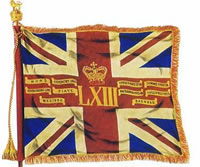 Made of silk and measuring up to 6 feet 6 inches long by 6 feet deep, and carried on a pike 9 feet 10 inches tall, colours, stood proudly as the heart and soul of a regiment’s honour.
Made of silk and measuring up to 6 feet 6 inches long by 6 feet deep, and carried on a pike 9 feet 10 inches tall, colours, stood proudly as the heart and soul of a regiment’s honour.
Each infantry battalion had 2 colours, collectively called ‘a stand’; the King’s (or Queen’s) colour consisted of a Union flag with the regimental badge in the centre, while the regimental colour displayed the regiment’s number and badge in the centre, sometimes with a Union flag in the upper corner nearest to the staff.
What were colours used for?
In the confusion of battle, men would use the colours as a rallying point, and they were defended fiercely as symbols of the regiment’s honour and traditions.
Such large flags were not easy to handle, and they were carried in action by junior ensigns (as well as meaning a flag the ensign was also the lowest rank of commissioned officer in the British army), who were often very young. They would usually be accompanied, or at least watched over, by a guard of experienced NCOs (Non-Commissioned Officers) or privates, the group being known as the ‘colour party’.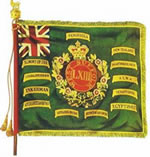
A battalion took enormous pride in its colours, to the extent that some of the fiercest battles raged over the attempt to capture them, and the British would in turn attempt to capture an enemy’s colours – imperial eagles in the case of the French army during the Napoleonic era (1793-1815).
What do the names that appear on some colours mean?
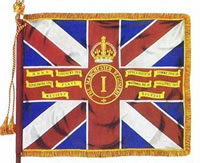 Regimental colours were more than a practical rallying point for its soldiers. They were also – and remain to this day – historical documents on which can be read the regiment’s history. These ‘battle honours’ are testament to the Regiment’s martial accomplishments.
Regimental colours were more than a practical rallying point for its soldiers. They were also – and remain to this day – historical documents on which can be read the regiment’s history. These ‘battle honours’ are testament to the Regiment’s martial accomplishments.
Prior to 1800 only 3 battle honours had been awarded. After this date they were awarded far more often. They may have been awarded to mark successful skirmishes, battles and campaigns such as ‘Egypt’ (1801).
Battle honours were often ‘backdated’, often by a century or more, so a regiment’s recognition may arrive 200 years after an action.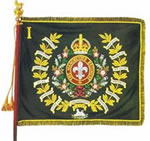
Despite this battle honours were fiercely earned and proudly worn. Not all battle honours can be displayed on a regimental colour so those that do appear have great significance for the regiment.
96th Regiment of Foot Regimental Colour
(c.1798-1812)
One of the Colours in the Museums Collection was conserved and reframed in 2009 with funding from the Renaissance North West Collections Care Development Fund  2008.
2008.
Prior to the raising of the 96th in 1824, later the 2nd Battalion of the Manchester Regiment, four other Regiments had carried the title, ‘96th’.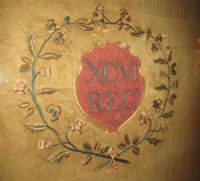
Following the capture of Minorca in 1798, Colonel John Stuart raised what was called the ‘Minorca Regiment’ from Swiss Prisoners of War found on the island. It fought with distinction at the Battle of Alexandria (1801) and later became known as the ‘Queen’s German’ Regiment.
In 1812, by Royal permission, the Regiment was restyled ‘Queen’s Own’ and its facings were changed to blue. It also received new Colours, and its old Colours, 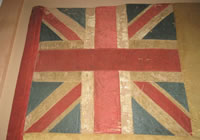 under which it had fought in places such as the Peninsula (1808-1811), were presented to Lieutenant-General Sir John Stuart who had been its commanding officer at Alexandria.
under which it had fought in places such as the Peninsula (1808-1811), were presented to Lieutenant-General Sir John Stuart who had been its commanding officer at Alexandria.
These old colours later came into the possession of the 2nd Battalion of the Manchester Regiment and were displayed in the Officer’s Mess until the amalgamation of the 1st and 2nd Battalions in 1948. Since 1948 they have been in the care of the museum.
 .
.

